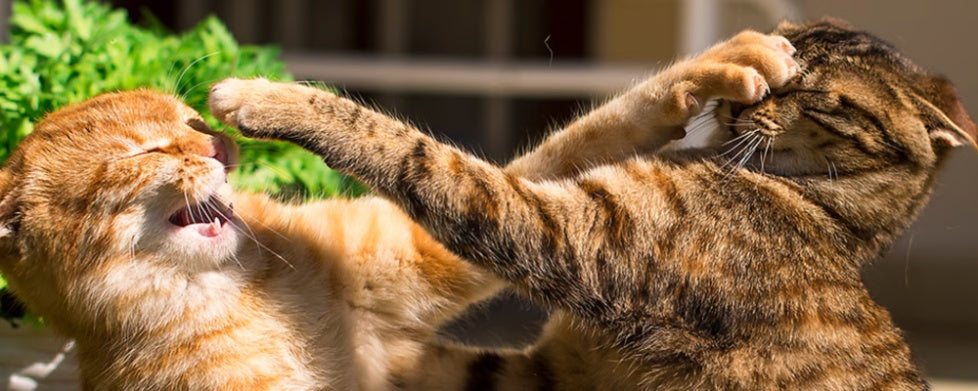Decoding Cat Aggression
Cats are often seen as independent and peaceful animals, but they can also exhibit aggressive behaviors. These instances of aggression may arise due to territorial disputes, fear, or even play that gets too rough. While occasional spats between cats can be normal, persistent aggression needs to be addressed to ensure a harmonious household. Understanding the different types of cat aggression is the first step toward resolving conflicts and fostering a peaceful coexistence.
1. Territorial Aggression
Cats are inherently territorial animals, and disputes over space are a common cause of fights. This type of aggression often arises when a new cat is introduced into the home or when cats feel their space is threatened. A cat exhibiting territorial aggression may hiss, swat, or chase the perceived intruder. Even small changes in their environment, like rearranging furniture, can trigger these behaviors.
To minimize territorial aggression, ensure each cat has enough personal space, including separate litter boxes, feeding areas, and resting spots. Gradual introductions when bringing a new cat into the home are also crucial.
2. Fear-Induced Aggression
Fear is another major cause of aggression in cats. This happens when a cat feels cornered or perceives a threat it cannot escape. Fear-induced aggression can occur in response to unfamiliar cats, loud noises, or stressful environments. Signs include flattened ears, dilated pupils, and a defensive stance.
The best way to address fear-induced aggression is by creating a safe, calming environment. Provide hiding spaces where the cat can retreat and avoid forcing interactions that may escalate their fear.
3. Redirected Aggression
Redirected aggression occurs when a cat becomes agitated by something it cannot access, such as an outdoor animal visible through a window. Frustrated, the cat redirects its aggression toward the nearest target—often another pet or even its owner. This can be particularly dangerous, as the aggression may seem sudden and unprovoked.
To prevent redirected aggression, block access to triggers like windows where other animals are visible. Providing engaging toys and interactive play can help redirect their focus to more positive activities.
4. Maternal Aggression
Mother cats are naturally protective of their kittens, and this protective instinct can sometimes lead to aggression. A mother cat may hiss, swat, or attack if she perceives a threat to her litter, even from familiar pets or humans. This behavior is temporary and usually subsides as the kittens grow older.
Respect the mother cat’s space and avoid interfering with her kittens unless necessary. Ensure that the environment is calm and secure to reduce her stress levels.
5. Play Aggression
Play aggression is common in younger cats, especially those that didn’t learn social boundaries during their developmental stages. What starts as playful stalking and pouncing can escalate into biting or scratching if one cat becomes overly excited. This behavior often mimics hunting instincts but can lead to injuries if unchecked.
To manage play aggression, engage your cat in structured play sessions with toys to channel their energy appropriately. Avoid using your hands as play objects to discourage biting or scratching.
6. Pain-Induced Aggression
Cats in pain can become irritable and lash out unexpectedly. This may happen due to chronic conditions like arthritis, dental problems, or injuries. Pain-induced aggression is often misunderstood as bad behavior, but it is a natural response to discomfort.
If you suspect pain-induced aggression, consult a veterinarian promptly to diagnose and treat the underlying issue. Addressing their pain can help alleviate this form of aggression.
How to Manage Aggression in Cats
1. Gradual Introductions
When introducing a new cat into the home, do so slowly. Allow the cats to sniff each other’s scent through a closed door before allowing face-to-face interactions. This helps reduce initial tension and territorial disputes.
2. Provide Separate Resources
Ensure that each cat has its own food and water bowls, litter boxes, and resting areas. This reduces competition and prevents resource-related aggression. For multi-cat households, a general rule of thumb is to provide one more litter box than the number of cats.
3. Create Vertical Spaces
Cats feel secure when they have access to elevated areas. Install cat trees, shelves, or perches to give them options for escaping or observing without conflict. Vertical spaces can help reduce territorial aggression by expanding their perceived territory.
4. Use Calming Aids
Pheromone diffusers and sprays can help create a calming atmosphere for stressed or anxious cats. These products mimic natural cat scents, promoting relaxation and reducing aggression.
5. Avoid Punishment
Punishing aggressive behavior can increase a cat’s stress and worsen the problem. Instead, use positive reinforcement to reward desirable behaviors, such as calm interactions or successful play sessions.
6. Consult a Professional
If aggression persists despite your efforts, seek advice from a veterinarian or certified animal behaviorist. They can help identify the root cause of the aggression and recommend tailored behavior modification techniques or medical interventions.
Conclusion: Fostering Harmony Among Cats
Understanding the reasons behind cat aggression is key to managing and preventing conflicts. Whether it’s territorial disputes, redirected aggression, or playful roughhousing, addressing the root cause with patience and care can make a significant difference. Creating a safe and stimulating environment, providing adequate resources, and using positive reinforcement are essential steps in ensuring peaceful coexistence.
By observing your cats’ behaviors and responding appropriately, you can help them build trust and reduce tension in your household. With time and effort, it’s possible to create a harmonious environment where your cats can thrive together.









